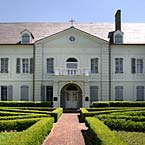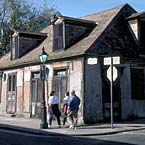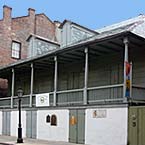French Quarter Fire and Flood



Top to bottom: Notable French Quarter Fire Survivors – Ursulines Convent, Lafitte’s Blacksmith Shop, Madame Johns Legacy
Of all the forces that conspire to destroy a city – time, storm, neglect, need – fire does the most harm. Without Prometheus, we might have more of our colonial city to preserve and savor. Two great fires in late eighteenth century New Orleans left the inhabitants few years to re-establish their institutions before the onset of American domination in 1803. Although several fine houses date to the last colonial decade, they and the French Quarter, including the Cabildo and the Presbytere, are conspicuously “Post-Fire.”
Looking at the vibrant, festive Quarter with millions of visitors annually, it is hard to imagine the devastation of Holy Saturday morning in 1788. Smoking ruins stretched from Chartres to Dauphine Street, and from Conti to St. Philip. The fire began on Good Friday morning in the home of Spanish treasurer Don Vincente Nunez at Toulouse and Chartres. It was a blustery March day, with the wind blowing out of the southeast (probably into a cool front). Within hours, over eight hundred homes and public buildings were reduced to ashes, including the church, the town hall, and the rectory on the Plaza de Armas. A saddened Governor Esteban Miro reported to Spanish authorities of the “abject misery, crying and sobbing” of the people. The faces of the families, he wrote, “told the ruin of a city which in less than five hours has been transformed into an arid and horrible wilderness; the work of seventy years since its foundation.”
The Second Great Fire
Rebuilding had scarcely begun when in 1794 a second fire and two hurricanes swept the city. The fire of December 8 that year burned 212 buildings – fewer, but more valuable. When both storms and both fires were all done, nearly all the public buildings, homes and businesses except those fronting the river had been consumed or badly damaged. Through it all the Ursuline nuns in their convent on Chartres Street had prayed to Notre Dame de Bon Secours, Our Lady of Prompt Succor, patron of Rouen, their home town. As the fire had neared the convent on that Good Friday, the wind changed suddenly. (As Providence would no doubt have it, the front arrived from the north just in time.) The convent survived, and is still here with us.
The results were fundamental to the Quarter. Baked tile and quarried slate replaced the roofs of ax-hewn cypress shingles. Buildings, set at the sidewalk or banquette, were of all brick, with common firewalls. The wide and shallow hipped roof, galleried townhouse perfected in the French period gave way to vertical, long and narrow Spanish-style town homes, many with overhangs, iron work and entresols or mezzanines. The Cabildo and Presbytere came into being. A new church rose from the ashes. A suburb opened on the upper side of town for residents wary of crowded Quarter conditions. Fire pumps were commissioned. The market moved riverside. Artisans were called in. Protestants gained a foothold. But people went homeless, the city indebted, and lives were lost to death or removal. The city was different.
Every Quarter Square Scarred by the Elements
Since the two Great Fires, Providence has not seen fit to visit the Quarter with any more all-points conflagrations up to the moment. But hardly a square in the Quarter has not had its smaller fires. And hurricanes keep coming. A great storm of August 19, 1812 swept away a brand new, year-old French Market building. Another in 1915 damaged the steeple of St. Louis Cathedral. The popular Orleans Theater and Orleans Ballroom burned in September 1816; rebuilt, the theater burned again in 1866. Fire damaged the Bank of Louisiana on Royal Street, today the home of the Vieux Carré Commission, resulting in the monumental columns installed in the remodeling.
Today, the French Quarter fire code is stringent. Motorized Mardi Gras parades are forbidden. Any Quarter fire signals an instant citywide fire alarm. The intent is to prevent fires from spreading. Still, the most important fires of the Twentieth Century occurred at individual structures. Social historians consider the burning of the Old French Opera House on Bourbon in 1919 the “final nail” in the coffin of the old Creole culture in the Quarter. But others espoused that culture, treasuring its memory. When the Cabildo burned in 1988, two hundred years after the First Great Fire, citizens felt the loss keenly. Carefully restored, it stands a proud reminder of a city’s resolve to safeguard its heritage.
Sally Reeves is a noted writer and historian who co-authored the award winning series New Orleans Architecture. She also has written Jacques-Felix Lelièvre’s New Louisiana Gardener and Grand Isle of the Gulf – An Early History. She is currently working on a social and architectural history of New Orleans public markets and on a book on the contributions of free persons of color to vernacular architecture in antebellum New Orleans.






